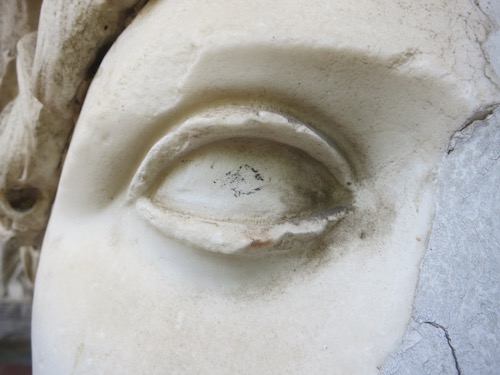Chapter 7
The Sculptures, Revisited
Section 3
Relief of a Helmeted Man
Next to the folding door that leads into the house, an oval marble medallion is walled into the back of the Breakfast Bower. It presents in high-relief an over life-size profile bust (in “cameo-style”). The bust shows a helmeted, beardless young man with curly hair looking to the right.

Medallion.
Photo: Annetta Alexandridis.
The medallion is a kind of “collage”, assembled from numerous fragments, ancient and modern, that were fixed to the marble back ground with a layer of stucco. The helmet, for example, carved with the hair in one piece constitutes one of these fragments. Its shape has no exact equivalent in the ancient world. The flat, cap like contour reminds the petasus (traveler’s hat) of the messenger god Hermes/ Mercury. Yet his hat often displays little wings at the sides.
The helmet’s slightly gradient rim on the Sonnenberg medallion is retracted above the ear where one would have to imagine a cheek piece, such as on gold coins depicting the Greco-Bactrian King Eucratides (ruled in central Asia, ca. 171-145 BCE).
This suggests that the marble helmet is not ancient, but was made by a sculptor who had some familiarity with ancient art.
Another fragment instead, the ear, might have come from an ancient statue. That is also the case for face and neck. They once must have belonged to the head of an over life size statue. (Only the nose is a modern addition in concrete or grey stucco.) The thick straight border at the base of the neck indicates that it was probably made for insertion in a larger statue body.

Medallion, close up.
Photo: Annetta Alexandridis.
We cannot tell who the sculpture depicted. Smooth surface and the regular almond-shaped eyes with sharp lined eyebrows suggest at least that it was not a portrait, but represented a deity or personification. The lack of an Adam’s apple could mean that the head belonged to a female or effeminate figure, such as the androgynous gods Apollo or Dionysus or a youthful hero. This would be further underscored by the heavy cheeks and chin and the thick neck. Light vertical incisions in the area of the larynx indicate body fat. Art historians call them “rings of Venus” for soft flesh and ample contours corresponded to the ancient ideal of female beauty.

Detail of neck.
Photo: Annetta Alexandridis.
When reused on the cameo-style medallion, the head (in whatever state the sculptor found it) was roughly sawn in half and, combined with other fragments, unequivocally turned into a male figure. This could have happened at some point in the 18th century, for which the inventories of the Palazzo Giustiniani might provide some clues. Until 1757 they mention a pile of over almost hundred marble fragments of body parts (heads, arms, thighs, buttocks, feet etc.). In 1793, these seem to be gone; but the inventory, composed by renowned sculptor and restorer Vincenzo Pacetti (1746-1820), mentions a medallion on top of an entrance door “representing an Alexander with helmet on his head, larger than nature in size.”1 Pacetti obviously felt the need to identify the image of a young warrior as a famous man of the ancient world, in this case Alexander the Great. Late inventories are again more matter-of-fact. In 1900 we read: “Relief: Head of a youth with little beard, covered with a Roman helmet. Nose, and apparently also helmet restored. Of little value.”2 (The face is clean shaven. It seems that the recorder, who saw the medallion from below, took the losses on the cheeks for side burns.)
The Metropolitan Museum was obviously of the same opinion as it did not keep the medallion but transferred it to Sonnenberg. Thanks to this decision the contemporary visitor to the mansion can get a close-up of how imaginative, but nonetheless informed sculptors of past centuries proceeded to reinvent ancient art!
Who knows what Mary Clark Thompson thought of this piece? The young warrior faces the garden and back entrance of the house as if he were a guardian. At some point somebody painted his eyes (as was the case with the Apollo and the bust of Cicero). Was it her? If yes, she would have been very much in line with the original collector, Vincenzo Giustiniani himself. The engravings in the magnificent first catalogue of his collection very much enliven the marbles, amongst others by adding pupils to their eyes.

Detail of painted eyes.
Photo: Annetta Alexandridis.
A.A.
Ithaca, NY
December 2017
1 Angela Gallottini, Le sculture della collezione Giustiniani I. Documenti. Rome 1988, 248 no. 93 (“rappresentante un Alessandro con elmo in capo, di grandezza sopra naturale”).
2 Ibid. 292 no. 69. (“Rilievo: Testa di giovane con barbula coperta di elmo romano. Restaurato il naso e, come pare, anche l’elmo. Poco pregio.”)

